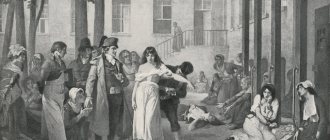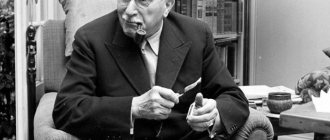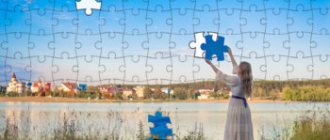Active imagination
Typically, these types of imagination are distinguished in psychology: active and passive. They differ not only in their internal content, but also in the main forms of their manifestation. Active imagination is the conscious construction of various images in your mind, solving problems and recreating connections between subjects. One of the ways it manifests itself is fantasy. For example, an author writes a script for a film. He invents a story based on real facts, which are embellished with fictitious details. The flight of thought can lead so far that in the end what is written turns out to be phantasmagoric and virtually impossible.
crime bosses)
A special manifestation of active imagination is a dream - the mental creation of images of the future. So, we often imagine what our house by the sea will look like, what car we will buy with the saved money, what we will name our children and what they will become when they grow up. It differs from fantasy in its reality and down-to-earthness. A dream can always come true, the main thing is to put all your efforts and skills into it.
Story
The essence of the method was first demonstrated by Carl Gustav Jung in his article “The Transcendental Function,” which was written in 1916 but published only in 1957. The method was first publicly shown by the creator of analytical psychology in 1928 in the book “Relations between the ego and the unconscious” (§§341-373) and a year later in the preface to the translation of the Chinese treatise “The Secret of the Golden Flower” by Richard Wilhelm; Jung considered the preface to the treatise to be a continuation of the previous book. In addition, the essence of active imagination is explained in detail in the Tavistock Lectures in 1935 (§§390-414).
How Imagination Manifests
Depending on the type of imagination, it manifests itself in different forms.
For active imagination it is:
- Thought experiment. Characteristic mainly for scientists. It is believed that Aristotle was the first to “conduct” such experiments, and Galileo widely popularized them. In the absence of opportunities to conduct an experiment in reality, this is the only behavior option for someone who wants to predict the result of their own actions.
- Fantasy. Has nothing to do with reality. It will not be possible to bring it to life simply because the objects that you can fantasize about do not exist in reality. But the result could be, for example, a science fiction novel.
- Dream. A clear image of what you want, what you can get in reality. It can be both useful and harmful. In the first case, it is an incentive to take action aimed at achieving it; in the second, it is a tendency to “hover in the clouds” without doing anything useful.
Passive imagination manifests itself as:
- Dream. It is generated by a healthy psyche. Reflects an emotional attitude to the experience. Other options for their interpretation are the “translation” of information from operational to long-term memory or the satisfaction of subconscious needs.
- Hallucination. Typically for a awake person with mental disorders, or under the influence of alcohol, drugs, or psychotropic substances. It is not reality, but it is perceived as such.
- Dream. It differs from a dream in that it has little or no relation to objective reality. This is a pleasant but illusory alternative to reality.
Accordingly, a person’s lack of imagination means for him the complete impossibility of any progress.
Notes
- , With. 284, 300—312.
- .
- .
- , With. 29, 47.
- .
- , With. 183-184.
- , With. 251.
- Gagarin A.P.
// Physical encyclopedia: / Ch. ed. A. M. Prokhorov. - M.: Great Russian Encyclopedia, 1994. - T. 4: Poynting - Robertson - Streamers. - P. 460. - 704 p. — 40,000 copies. — ISBN 5-85270-087-8. - , With. 247-248.
- , With. 242, 245—246, 248.
- Ellenberger G.
Discovery of the unconscious: History and evolution of dynamic psychiatry = The discovery of the unconscious. - M.: Academic project, 2021. - T. 1. From primitive times to psychological analysis. - pp. 450-453. — 550 s. — (Psychological technologies). — 300 copies. — ISBN 978-5-8291-2159-4. - , With. 244, 248.
- , With. 249.
- , With. 47.
- , With. 45.
- Samuels E.
Jung and the Post-Jungians: A Course in Jungian Psychoanalysis = Jung and the Post-Jungians. - M.: CheRo, 1997. - P. 388. - 416 p. — ISBN 5-88711-042-2. - Leiner H.
Catathymic experience of images: The main stage. - Nizhny Novgorod: Eidos, 2015. - P. 11, 13. - 252 p. - Linde N. D.
Fundamentals of modern psychotherapy. - M.: Academy, 2002. - P. 168. - 208 p. - (Higher education). — 30,000 copies. — ISBN 5-7695-0981-3. - Bolle R.
Schattengeschwister… Die Aktive Imagination nach CG Jung und die Katathym-Imaginative Psychotherapy (KIP) nach H. Leuner // Mit Imaginationen therapieren: Neue Erkenntnisse zur Katathym-Imaginativen Psychotherapy / L. Kottje-Birnbacher et al.
- Pabst Science Publishers, 2005. - P. 37-50. — 392 p. — ISBN 3-89967-266-6. Russian translation: Bolle R.
Shadow sisters... The method of “active imagination” according to K. G. Jung and Catathymic-imaginative psychotherapy according to H. Leiner // Symvoldrama: magazine. - M.: MOO SRS KIP, 2010. - No. 2 (5). - P. 18-35.
Passive
Passive (involuntary) imagination means the emergence of images that does not require conscious effort from a person.
With weakened conscious control, they arise by themselves, without a person’s volitional effort.
The source of their occurrence is not a logical connection and a person’s awareness of reality.
The passive images that arise often serve as a reflection of his internal state, fears, aspirations, desires, and speak about the personal needs of the individual.
Involuntary imagination is often not subject to logical comprehension, often representing a combination of completely contradictory images.
It is also often difficult to verbalize it after the experience, since such images are often symbolic, abstract and incomprehensible to other people.
Passive imagination is governed by two basic principles:
- Each affect strives to be preserved by exaggerating the subjective logical value of ideas. Thus, a cheerful person will more often have positive images, and a sad person, on the contrary, will have sad ones.
- A person strives to preserve pleasant experiences, and, therefore, pleasant images that arise.
Often passively arising images are not tied to time. Thus, the person observing them also loses the sense of time.
Subspecies
Passive imagination is divided into two subtypes:
- unintentional. Includes hallucinations, dreams and daydreams. They arise on their own, without the volitional participation of a person;
- intentional - hypnotic states caused by another person.
Description
- Dreams.
On the scale of voluntariness, they occupy the position furthest from awareness. Often in dreams we see bizarre images and strange plots. Nevertheless, they are important for the regulation of a person’s psycho-emotional state, since they are not only echoes of what a person has previously heard and seen, but also represent material that has been very deeply processed by the psyche. - Dreams. Dreams, like daydreams, are often a departure from reality, with the difference that dreams are aimed at the future, and daydreams replace the present. For example, a schoolboy who is offended by his comrades may imagine how he takes revenge on the offenders. In this case, the emerging images will represent an alternative reality, bringing the student some satisfaction, but at the same time leading him away from the real state of affairs.
Hypnotic states. The deeper the hypnotic trance, the less attention a person pays to external stimuli, the less real reality means to him. The subjective sense of time may also change, and negative hallucinations may arise - when a person does not see real objects. Only the connection with the hypnotist inducing the trance is maintained. Hypnotic trance is quite often used in psychotherapy.
Hallucinations. Hallucinations usually occur in people with congenital physiological brain damage, as a result of traumatic brain injury, viral infections, and the use of psychotropic substances. Often perceived as genuine reality.
What do psychologists mean by imagination?
If we try to collect some kind of “arithmetic mean” from the definitions that various specialists in the field of psychology give to the imagination, then it can be described as a more or less controlled ability of the individual’s consciousness and subconscious to “construct” images, ideas, ideas, objects that they personally do not were perceived (or in principle could not be perceived) through the senses, and manipulate them.
In fact, this is the “base” for imaginative thinking - imagination provides a person with invaluable help when doing something in practice is impossible, problematic or impractical.
The first attempt to define the phenomenon was made by T. Ribot. The main thesis of his works is “to imagine is to depict.” Accordingly, imagination is the process of creating images, ideas and concepts, “reshaping” and “combining” one’s own experience and obtaining something completely new based on it.
Imagination in psychology (its types were not identified at first) was also interpreted by the first Russian researchers as a process. In their opinion, any process accompanied by the creation of images and mental control of them could be considered such. This point of view was held by A. Petrovsky and M. Yaroshevsky; among modern authors, V. Kazakov and L. Kondratieva continue to share it.
Further, a very “vague” definition was narrowed and specified in the works of M. Gamezo and I. Domashenko. They understood imagination as the process of creating new images and ideas taking place in the psyche on the basis of evaluating and processing previous experience.
Later, interpretations of imagination as an ability (V. Kudryavtsev), specific activity of the nervous system (B. Teplov, L. Stolyarenko) appeared.
Taking into account the complexity of its functioning, L. Vygotsky even spoke of a “psychological system” in which imagination is inextricably linked with thinking and emotions
The original idea was expressed by E. Ilyenkov, according to whom, the described process is only a “derivative”, a “side effect” of the imagination itself. And its essence is the ability to see reality with the eyes (that is, the body’s ability to create an image of an object from the surrounding reality on the surface of the retina). The author of the hypothesis considers imagination as an optical phenomenon.
Recently, the “focus” of research on this phenomenon has shifted somewhat. Particularly relevant is the study of the essence of creativity, the search for principles and diagnostic methods that make it possible to identify and develop appropriate abilities in children at an early age. Among the specialists involved in this, we can note A. Brushlinsky, A. Ponomarev, V. Krutetsky, A. Petrovsky.
Among foreign specialists, a huge contribution to the development of the phenomenon of imagination was made by J. P. Guilford, who, in fact, is the creator of the psychology of creativity. He replaced the term “imagination” with the words “divergent thinking,” by which he meant the creation of new, original and unique ideas, the main purpose of which is self-expression. This type of thinking is fluent, flexible, and accurate.
From the point of view of physiologists, imagination is the actualization, regrouping and disintegration of neuronal connections, the creation of new systems from them. As a result, images appear that are not the lived experience, but are closely related to it.
The complexity, spontaneity and unpredictability of the phenomenon, its connection with the emotional sphere gives reason to believe that the process occurs not only in the cerebral cortex, but also in the hypothalamic-limbic system.
Notes
- Jung K. G.
Transcendental function // Consciousness and the unconscious: Collection. - St. Petersburg: University Book, 1997. - P. 284, 300-312. — 544 p. - (Classics of psychology). — 10,000 copies. — ISBN 5-7914-0012-8. - .
- .
- , With. 29, 47.
- .
- , With. 47.
- , With. 45.
- Samuels E.
Jung and the Post-Jungians: A Course in Jungian Psychoanalysis = Jung and the Post-Jungians. - M.: CheRo, 1997. - P. 388. - 416 p. — ISBN 5-88711-042-2. - Leiner H.
Catathymic experience of images: The main stage. - Nizhny Novgorod: Eidos, 2015. - P. 11, 13. - 252 p. - Linde N. D.
Fundamentals of modern psychotherapy. - M.: Academy, 2002. - P. 168. - 208 p. - (Higher education). — 30,000 copies. — ISBN 5-7695-0981-3. - Bolle R.
Schattengeschwister… Die Aktive Imagination nach CG Jung und die Katathym-Imaginative Psychotherapy (KIP) nach H. Leuner // Mit Imaginationen therapieren: Neue Erkenntnisse zur Katathym-Imaginativen Psychotherapy / L. Kottje-Birnbacher et al.
- Pabst Science Publishers, 2005. - P. 37-50. — 392 p. — ISBN 3-89967-266-6. Russian translation: Bolle R.
Shadow sisters... The method of “active imagination” according to K. G. Jung and Catathymic-imaginative psychotherapy according to H. Leiner // Symvoldrama: magazine. - M.: MOO SRS KIP, 2010. - No. 2 (5). - P. 18-35.
Properties and characteristics
V. Stern and D. Dewey were actively involved in the study of the properties and characteristics of imagination. They viewed it as an inherently human, “given” ability.
They understood the originality of imagination in its inherent properties:
- this is the mental exit of the individual beyond the limits of what he directly perceived and experienced;
- this is an image of the desired future or a “visible” result of a certain activity;
- This is an opportunity to “revive” and “replay” what happened.
According to the same researchers, imagination has the following characteristics:
- Brightness and clarity. They took it as an axiom that in children it is more vivid and original than in adults, because in the latter the flight of imagination is greatly limited by critical thinking.
- Realism. The degree of coincidence of imaginary images and ideas with reality.
- Controllability. The ability of consciousness to influence and control the course of the imagination process, changing certain parameters or general direction at the discretion of the person.
- Image activity level. The generally accepted point of view is that the more emotionally rich the images created, the more active they are. For example, the fear of a neurotic can completely “replace” what actually happened with an imaginary development of events. The degree of activity is the ability of images to be motives of activity and behavior, their regulators. The maximum motivating force is inherent in ideals and phobias, the minimum - in dreams and fantasies.
Imagination in psychology, the types of which do not have stable characteristics (even individual ones), is an objective reality. They vary greatly depending on how significant the image being created is for a particular person.
Healing with Imagination
Psychologists say that the best way to become healthy is to imagine yourself as such. A thriving and vibrant image in our minds quickly becomes a real fact, and the disease recedes. This effect is described in detail by both medicine and psychology. The topic “Imagination and Its Impact on Oncology” was studied in detail by Dr. Cal Simonton, a leading cancer specialist. He argued that meditation and auto-training helped even those patients who were diagnosed with the last stage of the disease to recover.
The result amazed everyone: after a year and a half, some patients did not even have traces of the disease. Dr. Simonton is confident that positive images in our brain, will and desire can work real miracles. Imagination is always ready to be embodied in real form. Therefore, where there is war, it is worth imagining peace, where there are quarrels - harmony, where illness - health. Man has many hidden abilities, but only imagination gives us the opportunity to rise above all limitations, transcending space and time.
Psychology of imagination and its possibilities
Each of us has many hidden abilities. They are suppressed by many restrictions. The power of imagination allows us to cope with them - to overcome time and space, laziness and apathy, inertia and prejudices. Without it, many things in our lives would be impossible, including:
• get to know yourself and the world around you with the help of vivid images and various manipulations with them;
• achieve emotional release, including during meditative training, for example, when performing the practice of gaining energy;
• regulate relationships with people: convince them, influence their decisions, eliminate conflicts;
• achieve better health through relaxation therapy;
• enjoy the work of great artists, composers, writers.
The power of imagination is capable of transforming reality beyond recognition. Of course, much depends on the direction of this force. Let's not forget about the harm of fruitless illusions and sick fantasies, obsessions and delusional thoughts.
But let us remember that imagination is a great gift that made the upright primate the crown of nature
According to Anatole France, it can turn a sensitive person into an artist, and a brave person into a hero. And according to Denis Diderot, without imagination there can be neither a thinker, nor a poet, nor just a person
Imagination concept
What does "cognitive" mean? In this context, this means that imagination helps a person to understand the world around him and use this knowledge as the person sees fit. Based on the information received, a person can create new images. It is impossible to come up with something new if you don’t know the old.
Therefore, any brilliant discoveries that scientists have made are the result of fruitful work, not talent. Every person is talented. It’s just that his level of experience doesn’t allow him to fully imagine. This is quite difficult for him.
How does imagination arise? It is a consequence of the needs that a person has in life. Everyone wants to change something, but from the very beginning you need to imagine the finished result, and then go towards it. The inventor first imagined any object in his imagination, and then brought it to life. Imagination is an excellent tool for visualizing goals.
Imagination was developed in man thanks to work. A well-known genius among physicists, A. Einstein, said that imagination is better than knowledge, since it can create something that can significantly influence the processes occurring in the world. Many imaginations arise in a person’s head every day. Their number in most cases exceeds a thousand.
Some of them leave no trace. They are not remembered as those that mean little. But the most interesting ones can stay in a person’s head for a long time. They form the content of the imagination. The appearance of the iPhone in Steve Jobs's head was preceded by a series of other imaginations that the genius of the mobile industry did not even remember. But since the idea of the iPhone was beyond praise, it was even brought to life.
So, imagination is a process that involves creating new images; this occurs due to the processing of material from perception and experience (memory).
Purpose and functions
The role of imagination is represented by the following points:
- the ability to represent reality using images, the ability to use them;
- in an unforeseen event, an individual can form a plan of action;
- the ability to regulate the emotionality of relationships;
- regulation of individual cognition processes.
Imagination allows one to go beyond the limits of human understanding, helps to foresee the future, and brings the past to life.
I bring to your attention the functions of imagination.
- Encouraging active activity with the help of an attractive, vivid image of the result.
- The presence of certain plans and ways of implementing plans.
- Psychotherapy, emotional self-regulation, illusory satisfaction of one's needs. Based on this feature, there is a risk of losing reality. A particular example of replacing reality with images from games, a consequence of gambling addiction.
- The ability to regulate one’s behavior in non-standard situations, sometimes problematic, with the help of alternative actions, new images, taking into account possible consequences.
- Organization of cognition, modeling, reconstruction of objects according to a detailed description, completion of missing elements.
Story
The essence of the method was first demonstrated by Carl Gustav Jung in his article “The Transcendental Function,” which was written in 1916 but published only in 1957. The method was first publicly shown by the creator of analytical psychology in 1928 in the book “Relations between the ego and the unconscious” (§§314-373) and a year later in the preface to the translation of the Chinese treatise “” by Richard Wilhelm; Jung considered the preface to the treatise to be a continuation of the previous book. In addition, the essence of active imagination is explained in detail in the Tavistock Lectures in 1935 (§§390-414).
What types of imagination are there?
Imagination also gives us the ability to see things from other perspectives and empathize with others. It expands our experiences and thoughts, allowing us to create our own worldview, which reduces our feelings of uncertainty.
In this way, our imagination fills in gaps in knowledge, allowing us to create mental maps that help us get out of difficult situations in life. Our brains use different types of imagination at different times in our lives.
The imaginary world that a person imagines is part of our representation of real events and material objects. There are several types of imagination
Passive
Passive imagination is the creation of certain images that are initially perceived by a person as unreal.
It also creates images in special personality states when a person does not control the process of creating these images.
Most often it is based on fears or desires that are considered feasible in the process of fantasy;
2.Active
This is how we fantasize if we ourselves want to. This kind of imagination can be seen in the work of designers or writers. We purposefully create images in our heads.
Most often, this form manifests itself in creative activities not only among professionals, but also, for example, in children's role-playing games;
3.Creative
Creative imagination is one of the varieties of active imagination. Its difference is that it usually has practical benefits and value for other people or society as a whole.
Imagination helps a person to manifest his thoughts, desires and dreams. For creative people, imagination plays a huge role in their life journey.
For example, after looking at a graph with the latest equipment, we will already have an idea of what it is and what functions it performs. Coming up with something of your own using only creative imagination is quite difficult;
4.Free
Voluntary imagination is also a type of active imagination. This type differs from the previous ones in that at the moment of action a person is aware of the goals and motives for creating the image.
An example of this type of imagination is a situation when a person thinks about something that most likely will not come true or the likelihood of this happening is negligible;
5. Recreating
Recreating imagination is the creation of images of objects by a person that were not previously perceived by him in their entirety.
Images are created from descriptions in words, pictures, drawings, maps of any area. Our imagination recreates what happened in our heads and fills in the gaps thanks to this form of imagination.
So, we have looked at the most famous types of fantasies, which fully reveal the essence of the imagined consequences and the principles of their action.
Literature
- Bennett E.-A.
What Jung really said. - M.: AST: Astrel, 2009. - P. 96-100. — 160 s. - (Philosophy). — 2,500 copies. — ISBN 978-5-17-055779-0. - Dieckmann G., Jung E.
Further development of analytical (complex) psychology // Encyclopedia of Depth Psychology: In 4 volumes = Tiefenpsychologie: 4 Bände / Ch. ed. D. Eike. - M.: Cogito-Center, MGM, 2004. - T. IV. Individual psychology. Analytical psychology. - pp. 368-370. — 588 p. - (Psychologie des 20 Jahrhunderts). — 4,000 copies. — ISBN 5-89353-076-4. - Franz M.-L.
background. Alchemical active imagination = Alchemical active imagination. - M.: Club Kastalia, 2021. - 236 p. - .
Meeting with the soul. Carl Gustav Jung's method of active imagination = Encounters with the Soul: Active imagination as developed by CG Jung. - M.: Club Kastalia, 2015. - 304 p. — ISBN 978-5-519-60682-0. - Jung K. G.
Commentary on “The Secret of the Golden Flower” // On the psychology of Eastern religions and philosophies. - M.: Medium, 1994. - P. 165-167. — 240 s. — (First publications in Russia). — 15,000 copies. — ISBN 5-85-691-010-9. - Jung K. G.
Relationships between the ego and the unconscious // Essays on the psychology of the unconscious = Two essays on analytical psychology. — 2nd ed. - M.: Cogito-Center, 2010. - P. 241-254. — 352 p. — 2,000 copies. — ISBN 978-5-89353-240-1. - Jung K. G.
Tavistock Lectures // Symbolic Life = The Symbolic Life. — 2nd ed. - M.: Cogito-Center, 2010. - P. 181-194. — 326 p. — (Carl Gustav Jung. Works). — 2,000 copies. — ISBN 978-5-89353-241-8. - Chodorow J.
// International Dictionary of Psychoanalysis = Dictionnaire international de la psychanalyse / Ed. in chief A. de Mijolla. - Thomson Gale, 2005. - P. 14-15. — 2196 p. — ISBN 0-02-865924-4. - Weaver R.
The old wise woman: A study of active imagination. — 1st ed. - V. Stuart, 1964. - 143 p.
Passive imagination
Like other cognitive processes, imagination can be voluntary, that is, purposeful and regulated by our consciousness and volitional processes. But there is also involuntary imagination, which is associated not with conscious mental activity, but with the processes of the subconscious.
The degree of unconsciousness and involuntary imagination may vary. I think all of us have experienced a state when thoughts, images, ideas appear as if on their own, regardless of our desires. The thought freely “wanders in the convolutions” of the brain. Pictures and ideas pop up in your head; they are combined, modified, and evoke new associations. Sometimes at some stage we may become interested in a spontaneously arising thought and take control of the imagination process.
In such a situation, we are not only fully capable of controlling this mental process, but we also distinguish its images from the real ones, that is, we realize their fantastic nature. But there are other situations when the imagination is absolutely spontaneous, involuntary and passive, that is, the participation of images in any active activity is not even expected.
Passive involuntary imagination
This type of imagination includes dreams and hallucinations.
- Dreams are the product of a healthy psyche, their visions are the result of complex processes of excitation and inhibition in the cerebral cortex. Inhibition allows our subconscious, where a huge amount of figurative information is stored, to become more active. At the subconscious level, images intertwine and mix, giving birth to new combinations, like in a children's kaleidoscope. And such unusual pictures and intricate plots become the content of our dreams.
- Hallucinations, unlike dreams, are the result of painful conditions when brain activity is disrupted. This may be delirium during a serious illness, a consequence of alcohol and drug intoxication, or the result of mental disorders. Sometimes hallucinations occur in response to severe emotional shocks, when a person's level of rational control is sharply reduced.
Despite their differences, these two types of imagination are united by man's inability to control them. But there are types of passive, unproductive imagination that are completely conscious and controllable, although they often arise spontaneously and to a certain extent involuntarily.
Passive voluntary imagination
This type includes two very close and similar mental phenomena - dreams and reveries. One of the most important functions of imagination is predictive. Thanks to it, we can foresee developments in the future, not only probable, but also unlikely and even completely incredible. Why not? The power of our imagination is such that we are able to imagine anything: even a prince in a white Mercedes, even winning the lottery, even a dizzying success at work.
What is imagined does not always come true - there are not enough princes for everyone. But why not dream?
- Dreams are not just fantasies, but images of the desired future. They can be realistic to one degree or another, many of them require certain conditions and efforts for their implementation, but are quite achievable. And most importantly, even being a type of passive imagination, a dream encourages a person to be active.
- Dreams, unlike dreams, have no relation to reality; they are solely a product of our imagination, and, as a rule, a person does not even imagine doing anything to make dreams come true. This may be a pleasant, but illusory fulfillment of reality.
The boundary between a dream and a daydream is very fluid, sometimes it is difficult to notice, but the differences can be understood with a simple example. A girl, reading a book in the fantasy genre, imagines herself in the place of a heroine who finds herself in a fairy-tale world, where three princes or dark lords fall in love with her. It's a dream. And if a girl thinks that someday she will also write and even publish a similar book, then this is a dream. And with proper effort, it is quite feasible.
Functions of the imagination
Fantasy and imagination play an important role in mental control. They are helping:
Eliminate the problem of emotional overload associated with the fact that we are waiting for some situation. After all, the signs of this problem are partially eliminated by imagining this situation. Long-term wishes are satisfied and there is no longer strong anxiety; Another of its functions is associated with the regulation of other cognitive abilities - perception, memorization, understanding, speaking
Formed images (based on associations), associated with the search for the desired object in the environment, direct a person’s attention to objects that correspond to them; Reproducing a situation that has already happened in your head makes the search for speech means in a conversation faster. You conduct the conversation measuredly, without tension; Another function of imagination allows a person to plan his actions for the future, imagine his goal and plan for its implementation, understanding intentions and means in general; A figurative idea of a future frightening situation partially prepares a person for it psychologically and allows you to think through an action plan in advance in case of failure.
Thanks to imagination, we live our lives much easier, because thanks to it it is easier for us to control our emotions and suppress obsessive desires.
Classification and levels of development
Studying the types and properties of imagination in psychology, psychologists have identified 2 forms of representation: passive, active. They are distinguished by the need to make volitional efforts, the result.
Intentional passive imagination is the creation of images that persist at the level of fantasy, dreams. Images replace reality and are a fantasy of a better life. The individual creates images consciously, fully aware that these are dreams. Understands that he is contrasting fantasy with the real world. If a person loses self-control and dissolves in fantasy, mental and social development slows down. An individual may completely lose touch with reality and begin to perceive fantasies as the only reality.
Unintentional passive imagination is the creation of images without awareness, spontaneously. The process starts when consciousness is weakened: in a dream, during mental disorders. The manifestation of images is hallucinations. A person sees invented images, but perceives them as objective, physical. Also a type of passive representation are dreams, in which unexpected versions of surreal images appear.
Active imagination is a process associated with a specific activity. It is directed to the external environment. Prompted by a task, it can be controlled and suppressed by willpower. It is used when an individual needs to evaluate his own activities from the outside. The ability to imagine is used to create an image and change it depending on the desired result. There are 3 types of active image creation:
- Recreating. Restores objects, detailing details realistically. Used when deciphering maps and reading books. With the help of internal images, the individual adds graphic images to text descriptions, enriching perception.
- Creative. Helps create new images, inventing them from scratch, without referring to text descriptions. Images created by creative imagination are valuable not only for their author, but also for other people. They are embodied in the form of musical works, paintings, books. Creative activity would be impossible without the representation of an object.
- Dream. Planning that does not require immediate implementation is called a dream. Unlike dreams, which replace reality, a dream is the creation of an action plan. It encourages activity and motivates a person to work.
The development of imagination depends on mental processes. In children, the ability for conscious representation is absent; it arises gradually as they acquire new cognitive functions.
Notes
- Jung K. G.
Transcendental function // Consciousness and the unconscious: Collection. - St. Petersburg: University Book, 1997. - P. 284, 300-312. — 544 p. - (Classics of psychology). — 10,000 copies. — ISBN 5-7914-0012-8. - .
- .
- , With. 29, 47.
- .
- , With. 47.
- , With. 45.
- Samuels E.
Jung and the Post-Jungians: A Course in Jungian Psychoanalysis = Jung and the Post-Jungians. - M.: CheRo, 1997. - P. 388. - 416 p. — ISBN 5-88711-042-2. - Leiner H.
Catathymic experience of images: The main stage. - Nizhny Novgorod: Eidos, 2015. - P. 11, 13. - 252 p. - Linde N. D.
Fundamentals of modern psychotherapy. - M.: Academy, 2002. - P. 168. - 208 p. - (Higher education). — 30,000 copies. — ISBN 5-7695-0981-3. - Bolle R.
Schattengeschwister… Die Aktive Imagination nach CG Jung und die Katathym-Imaginative Psychotherapy (KIP) nach H. Leuner // Mit Imaginationen therapieren: Neue Erkenntnisse zur Katathym-Imaginativen Psychotherapy / L. Kottje-Birnbacher et al.
- Pabst Science Publishers, 2005. - P. 37-50. — 392 p. — ISBN 3-89967-266-6. Russian translation: Bolle R.
Shadow sisters... The method of “active imagination” according to K. G. Jung and Catathymic-imaginative psychotherapy according to H. Leiner // Symvoldrama: magazine. - M.: MOO SRS KIP, 2010. - No. 2 (5). - P. 18-35.
Kinds
Active imagination enhances the motivation of activity and a person transforms reality - he invents, embodies an artistic concept, and brings closer the future he dreams about.
- Active reconstruction builds an image according to the description.
- Active creativity builds an image of something that has not yet existed.
All culture is created by creative imagination.
Passive imagination undermines the motivation of real behavior; images reproduce themselves. Dreams and projects multiply and do not become reality. A time-out is necessary, but the pause can drag on, and life will pass as if in a dream.
- Passive intentionality is controlled by a person who himself evokes memories, dreams, and fantasies.
- Passive unintentional controls a person when he accepts delusional, dreamlike images as reality.
Notes
- , With. 284, 300—312.
- .
- .
- , With. 29, 47.
- .
- , With. 183-184.
- , With. 251.
- Gagarin A.P.
// Physical encyclopedia: / Ch. ed. A. M. Prokhorov. - M.: Great Russian Encyclopedia, 1994. - T. 4: Poynting - Robertson - Streamers. - P. 460. - 704 p. — 40,000 copies. — ISBN 5-85270-087-8. - , With. 247-248.
- , With. 242, 245—246, 248.
- Ellenberger G.
Discovery of the unconscious: History and evolution of dynamic psychiatry = The discovery of the unconscious. - M.: Academic project, 2021. - T. 1. From primitive times to psychological analysis. - pp. 450-453. — 550 s. — (Psychological technologies). — 300 copies. — ISBN 978-5-8291-2159-4. - , With. 244, 248.
- , With. 249.
- , With. 47.
- , With. 45.
- Samuels E.
Jung and the Post-Jungians: A Course in Jungian Psychoanalysis = Jung and the Post-Jungians. - M.: CheRo, 1997. - P. 388. - 416 p. — ISBN 5-88711-042-2. - Leiner H.
Catathymic experience of images: The main stage. - Nizhny Novgorod: Eidos, 2015. - P. 11, 13. - 252 p. - Linde N. D.
Fundamentals of modern psychotherapy. - M.: Academy, 2002. - P. 168. - 208 p. - (Higher education). — 30,000 copies. — ISBN 5-7695-0981-3. - Bolle R.
Schattengeschwister… Die Aktive Imagination nach CG Jung und die Katathym-Imaginative Psychotherapy (KIP) nach H. Leuner // Mit Imaginationen therapieren: Neue Erkenntnisse zur Katathym-Imaginativen Psychotherapy / L. Kottje-Birnbacher et al.
- Pabst Science Publishers, 2005. - P. 37-50. — 392 p. — ISBN 3-89967-266-6. Russian translation: Bolle R.
Shadow sisters... The method of “active imagination” according to K. G. Jung and Catathymic-imaginative psychotherapy according to H. Leiner // Symvoldrama: magazine. - M.: MOO SRS KIP, 2010. - No. 2 (5). - P. 18-35.
Human imagination: tips for development
The simplest ways to develop imagination are:
- The accumulation of various vivid images from real life: observing nature, animals, viewing works of art (painting, sculpture), listening to the sounds of nature, classical music.
- Try to imagine in vivid colors a person whom you know, but who is currently not near you. Remember and imagine what he is like, how he smiles, the color of his eyes, the structure of his hair, the tilt of his head when talking.
- Try to come up with a non-existent animal and describe how it lives, what it eats, where it lives, how it interacts with other animals, what sounds it makes.
Imagine and develop!
Human imagination. Irina Permyakova
This article is part of a series of articles on imagination.
Part one What is the most important thing in intelligence?
Part two Human imagination | What is imagination?
Part three
Differences from similar techniques
According to Marie-Louise von Franz, the method of active imagination is on a par with such European meditation techniques as autogenic training by Johann Schulz (1932), “therapeutic meditation” (1932), “” (1938), methods and.
The differences between Jung's methods are as follows. Jung does not prescribe specific physical relaxation exercises to the patient, as in autogenic training. Active imagination does not force the patient to turn to a set of themes developed by the analyst, as with Karl Happich, who gives the patient a pre-prepared image like “meadow of childhood” or “mountain”. Finally, Jung suggests less active guidance of the patient's behavior during meditation on the part of the psychotherapist than provided by the Desauliers method.
What is imagination in psychology? Active and passive imagination
The list of images that a person operates with during his life includes not only objects or phenomena that exist in objective reality. It may also be something that was not previously perceived directly by the individual: the distant past or future, places where he has never been and will not visit, living beings that do not exist in the Universe. Answering the question what is imagination, the main characteristic of which is images that are amazing for everyday life, we can say that it is going beyond the real world both in time and in space.
However, everyday and scientific definitions of human fantasies differ greatly. In the first case, it is only everything unreal, not corresponding to the reality around us, and therefore not endowed with any practical significance. Scientists do not quite share the opinion of ordinary people about what imagination is. Defining it from a scientific point of view covers all aspects of an individual’s cultural life and provides an incentive for the development of artistic, scientific and technical creativity.
Man is the only living creature on our planet who tends to fantasize, that is, to reflect the future and act in accordance with the expected (imaginary) situation, using his sensations, perception and thinking.
Speaking about what imagination is in biology, we can say that these are cognitive processes of imagining any future events, which are based on the creation of new images, processed as a result of perception, thinking and knowledge about the world of a particular individual, which were obtained in previous life situations. The essence of any fantasy is the transformation of objective reality, in which objects and phenomena exist that have no points of contact with reality. It is this phenomenon that is most important in the process of becoming a person as an active subject.
Soviet psychologist Lev Semenovich Vygotsky called these two processes close in both structure and function. They are characterized as extremely related, with similar origins and structure. Speaking about what imagination is in psychology, the scientist considered it a necessary, integral moment of thinking, especially creative thinking, explaining this by the fact that the thinking process includes both forecasting and anticipation of events.
Various problem situations force a person to think, fantasize, form an idea in his mind about what can be done, strengthening the motivation to find a solution and determining its direction
The degree of uncertainty of controversial moments in life determines the importance of the role of the imagination, which carries out its functions even if the initial situation is incomplete, supplementing it with the products of its activity.
Basic ways to create images
There are several of them, but each of them characterizes the concept of imagination in psychology as a rather complex, multi-level process.
- Agglutination. By assessing and analyzing the qualities, properties and appearance of a particular object, we create in our imagination a new, sometimes bizarre image, far from reality. For example, in this way the fairy-tale character Centaur (the body of a man and the legs of a horse), as well as Baba Yaga’s hut (a house and chicken legs), and an elf (a human image and insect wings) were invented. As a rule, a similar technique is used when creating myths and tales.
- Emphasis. Isolation of one dominant characteristic in a person, object or activity and its exaggeration. This method is actively used by artists when creating caricatures and caricatures.
- Typing. The most complex method, based on highlighting the features of several objects and creating a new, combined image from them. This is how literary heroes and fairy tale characters are invented.
These are the basic techniques of imagination in psychology. Their result is already existing material, but transformed and modified. Even scientists, in their seemingly boring and dry field of activity, also actively use imagination. After all, they developed new types of medicines, inventions and various know-how using existing knowledge and skills. Having learned something special and most importantly from them, they create a completely new product. Thus, we can conclude: without imagination, humanity would never have known what progress is in all types of activities.
Purpose
Sometimes people believe that fantasies only cause harm. In fact, it is an important part of the psyche that performs a number of functions. The main one is that with the help of imagination a person can imagine the result of his activities.
Important! Fantasies are the best way to form motivation. When an individual knows exactly what he will receive as a result of his activities, then he works more conscientiously
In psychological research, it was possible to identify another function of the imagination - the ability to find an option for action in a problem situation. In a critical situation, a person can recreate a plan of action and find a way out
When an individual knows exactly what he will receive as a result of his activities, then he works more conscientiously. In psychological research, it was possible to identify another function of the imagination - the ability to find an option for action in a problem situation. In a critical situation, a person can recreate a plan of action and find a way out.
With the help of dreams, a person satisfies his needs and restores his emotional background. When you are in a bad mood, this allows you to distract yourself and relax.
Another main function is to improve cognition. Most inventions are born when a person wants to improve something or come up with something from scratch. Modeling is based on the development of imagination. It was thanks to ideas that all technology was created.
Literature
- Bennett E.-A.
What Jung really said. - AST: Astrel, 2009. - pp. 96-100. — 160 s. - (Philosophy). — 2,500 copies. — ISBN 978-5-17-055779-0. - Dieckmann G., Jung E.
Further development of analytical (complex) psychology // Encyclopedia of Depth Psychology: In 4 volumes = Tiefenpsychologie: 4 Bände / Ch. ed. D. Eike. - M.: Cogito-Center, MGM, 2004. - T. IV. Individual psychology. Analytical psychology. — P. 368-370. — 588 p. - (Psychologie des 20 Jahrhunderts). — 4,000 copies. — ISBN 5-89353-076-4. - Franz M.-L.
background. Alchemical active imagination = Alchemical active imagination. — Club Castalia, 2021. — 236 p. - Hannah B.
Meeting with the soul. Carl Gustav Jung's method of active imagination = Encounters with the Soul: Active imagination as developed by CG Jung. - Club Kastalia, 2015. - 304 p. - Jung K. G.
Tavistock Lectures // Symbolic Life = The Symbolic Life. — 2nd ed. - Cogito-Center, 2010. - pp. 181-194. — 326 p. — (Carl Gustav Jung. Works). — 2,000 copies. — ISBN 978-5-89353-241-8. - Jung K. G.
Commentary on “The Secret of the Golden Flower” // On the psychology of Eastern religions and philosophies. - M.: Medium, 1994. - P. 165-167. — 240 s. — (First publications in Russia). — 15,000 copies. — ISBN 5-85-691-010-9. - Jung K. G.
Relationships between the ego and the unconscious // Essays on the psychology of the unconscious = Two essays on analytical psychology. — 2nd ed. - M.: Cogito-Center, 2010. - P. 241-254. — 352 p. — 2,000 copies. — ISBN 978-5-89353-240-1. - Weaver R.
The old wise woman: A study of active imagination. — 1st ed. - V. Stuart, 1964. - 143 p.
Functions of the imagination
It is difficult to imagine a person who completely lacks imagination. If you think about it, in your environment there will be pragmatic, seemingly down-to-earth people. All their actions are dictated by logic, principles and arguments. But it is impossible to say that they have absolutely no creative thinking and imagination. It’s just that these cognitive processes are either underdeveloped or are in a “dormant” state.
- Cognitive. With the help of imagination, we expand our horizons, gain knowledge, acting in an uncertain situation based on our conjectures and ideas.
- Prediction function. The properties of imagination in psychology are such that they help us imagine the result of an activity that has not yet been completed. This function also shapes our dreams and daydreams.
- Understanding. With the help of imagination, we can imagine what is in the interlocutor’s soul, what feelings he is experiencing. We understand his problem and behavior, conditionally putting ourselves in his place.
- Protection. By predicting possible future events, we can thereby protect ourselves from troubles.
- Self-development. The properties of imagination in psychology allow us to create, invent, and fantasize with its help.
- Memory. We remember the past, which is stored in our brain in the form of certain images and ideas.
All of the above functions of the imagination are developed unequally. Each person has a dominant individual property, which often influences his behavior and character.
Interesting research
We have already seen that psychology considers the development of imagination in parallel with the progress of thinking. Its close connection with activity has also been proven, as evidenced by one story that happened to a certain violinist. For a petty crime he was sent to prison for several years. Of course, he was not given an instrument, so every night he played an imaginary violin. When the musician was released, it turned out that he not only had not forgotten the notes and compositions, but now controlled the instrument much better than ever.
Inspired by this story, doctors from Harvard Medical School decided to conduct a unique study. They divided the subjects into two groups: one played a real piano, the other played a fictitious one. As a result, those who imagined the instrument only in their thoughts showed good results. They not only mastered basic musical compositions, but also demonstrated good physical fitness. It turned out that their fingers were trained as if they were practicing on a real piano.
As you can see, imagination is not only fantasies, daydreams and the game of the subconscious, it is also what helps people work and create in real life. Psychologists say that it can be controlled and thus become more educated and developed. But sometimes you should be afraid of him. After all, false facts that our imagination gives us can push us to commit a crime. One only has to remember Othello to understand what troubles our flight of fancy can cause.










